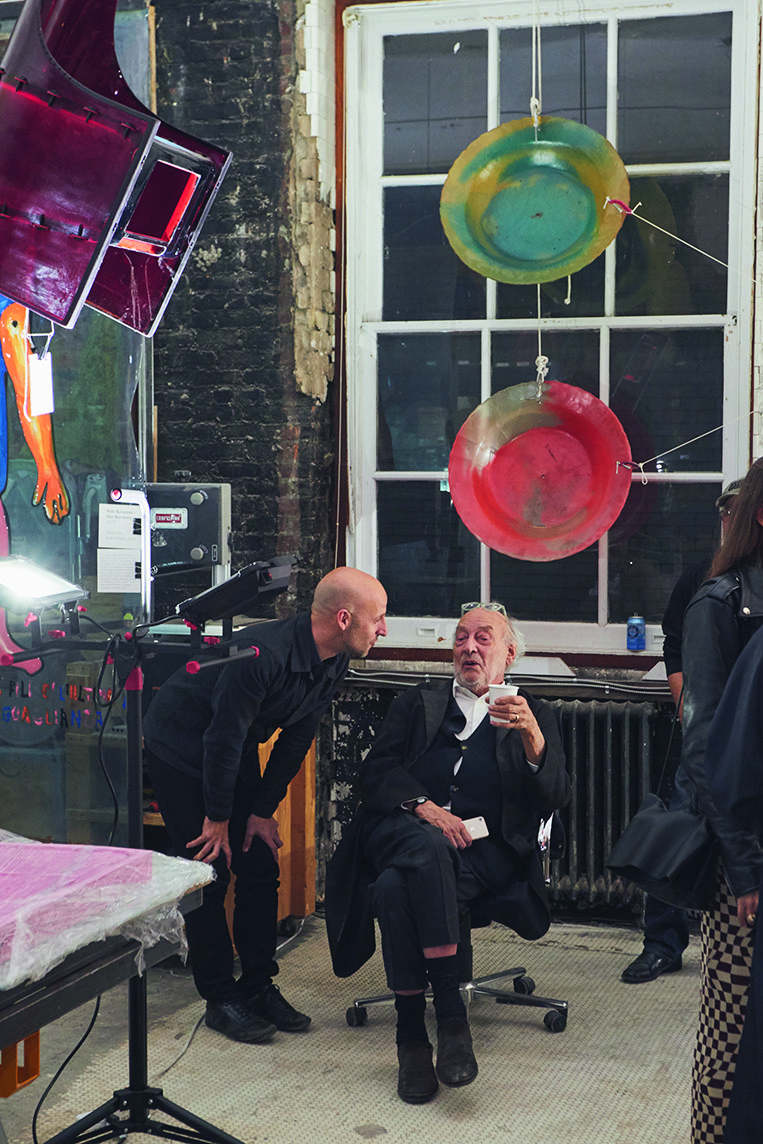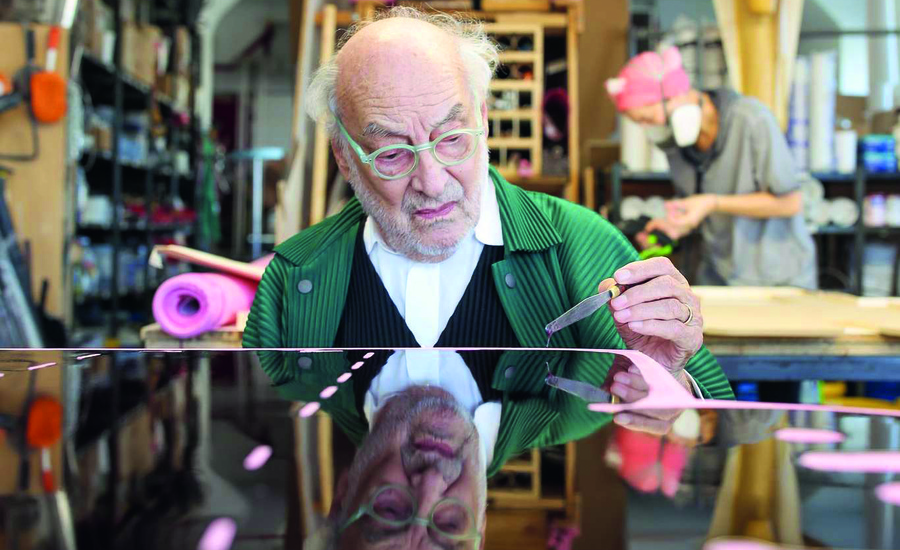Italian designer and architect Gaetano Pesce, a pioneer of the Radical Design movement who blurred the boundaries between art and design, has passed away at the age of 84. His studio announced the news on Instagram saying, “over the course of six decades Gaetano revolutionised the worlds of art, design, architecture and the liminal spaces between these categories,” adding that “his originality and nerve are matched by none.”
Pesce himself echoed this personal philosophy when he told Artspace on the launch of a series of limited edition sin May 2023:
“Most people enjoy repeating because people are lazy. I am not lazy. I like to use my energy all the time and this is the way creative people are supposed to be; and also politicians, and also philosophers and also musicians. This is the reality of the world, if it’s governed by people who have elastic minds, we’d be much better off.”
An episode from his early life proved to be profound in setting the course of his eternal quest for the new and untried. Shortly after his graduation from the University of Venice in 1963, Pesce reached out to local chemical companies, in the hope that they could tell him how to work with their wares.
"I realized that nobody taught me materials from my own time," the artist said. Two firms invited Pesce to visit, and he saw, as he later recalled, "incredible things." In particular, Pesce was taken with the possibilities offered by polyurethane resin and foam, that gloopy mid-century material, hard-wearing, translucent, and very easy to work with.
Despite Pesce’s Venetian roots, he believed that resin was superior to glass because "you work today; and tomorrow, it’s ready." This pliable, immediate, contemporary take on the world captured something of Pesce’s essence.
Unwilling to accept the overriding design consensus, the conventional hierarchy of material, or the tyranny of the ordered, clean lines of architectural modernity, Pesce over six decades, created colorful, figurative, charming and often gelatinous creations that remind us all that, at times, it's worth abandoning the spirit level and the set square, in favor of figurative forms and frivolity.
 Gaetano Pesce with Glenn Adamson, author of the Monacelli book The Complete Incoherence at his exhibition Working Gallery, 2019 at Salon 94 New York
Gaetano Pesce with Glenn Adamson, author of the Monacelli book The Complete Incoherence at his exhibition Working Gallery, 2019 at Salon 94 New York
“From the beginning, when I was 18 or 19, I thought that my way of thinking was supposed to be free, but before you are free on the outside you must free yourself inside,” he told Artspace on the launch of a series of limited editions last year.
“The principal thing is to observe. Time constantly tells us what we need to do; the question is to be able to capture the message of our time and that is constantly changing. We are meant to follow that, because if we don’t, we will become old in our mind.”
 Friend Skin, 1995. Image courtesy of the artist and Salon 94 Design. © Gaetano Pesce
Friend Skin, 1995. Image courtesy of the artist and Salon 94 Design. © Gaetano Pesce
Pesce’s storied, inventive mind remained active until the end. Yet despite his overriding rejection of the International Style, Pesce grew up and was educated very much within the European modernist tradition.
He was born on 8 November 1939 in La Spezia, not far from Genoa, in Northern Italy. The artist’s father served in the Italian navy and died during World War II, leaving Pesce’s mother to raise both him and his two siblings, with the help of his extended family across northern Italy. The region’s rich culture also served as a balm during these early years.
"Conversations about music and art helped us to survive," he later reflected.
Studying in Venice, Pesce was tutored by the great Venetian architect, Carlo Scarpa, and co-founded the avant-garde art collective Gruppo N with eight other architecture students. Following his graduation, he expanded his practice out to a wide variety of fields, including kinetic art, silk-screens, films, interior design and city planning.
The catalogue for the seminal 1972 MOMA exhibition, Italy: The New Domestic Landscape, not only featured Pesce’s striking 1969 UP 5 Donna or ‘Lady’ chair – a polyurethane foam chair shaped like a fecund, reclining woman – it also reproduced Pesce’s sci-fi account (told in words and pictures) of some future archaeologists’ discovery of a deserted, underground southern alpine city.
The notion of fallen civilizations may have drawn Pesce to New York; he settled in the city in 1980, to teach at the Pratt Institute, under the impression that, in his words, "New York was decaying, declining."
 Sunset in New York Sofa, 1980. Powerhouse collection. Gift of Cassina, 1985. Photo Jean-François Lanzarone.
Sunset in New York Sofa, 1980. Powerhouse collection. Gift of Cassina, 1985. Photo Jean-François Lanzarone.
This inspired his Sunset In New York sofa, a figurative rendering of a red sun setting on a city skyline, in which the tower blocks are armrests, and the sun’s corona a headrest.
However, he subsequently discovered NYC’s undying vibrancy and, in the intervening years, many of the city’s more tasteful residents grew to appreciate Pesce’s charming works.
His 1984 Green St Chair, made for Vitra, is widely recognized as a contemporary design classic, while his 1988 Crosby children’s chair – named after his studio’s street address – is a sought-after fixture in upscale playrooms everywhere.
 Bookcase from the apartment of Alberto Carenza, 1969.© Gaetano Pesce, courtesy of the Gaetano Pesce Office.
Bookcase from the apartment of Alberto Carenza, 1969.© Gaetano Pesce, courtesy of the Gaetano Pesce Office.
Though his work varied hugely, Pesce’s focus remained undying. For him, the enemy was the monotonous, clean lines of rectilinear, International Style modernism.
"To me, the International Style of architecture reflects a political ideology of sameness," the artist told the New York Times; "that we must all think the same way or dress the same way. I believe that the treasure of the world is diversity. To have one single ideology is a disaster. If we are the same, we cannot talk, because there is nothing to say. But if you and I are different, there’s a lot to exchange."
 Drawing, Pluralist Tower, 1987. © Gaetano Pesce, courtesy of the Gaetano Pesce Office.
Drawing, Pluralist Tower, 1987. © Gaetano Pesce, courtesy of the Gaetano Pesce Office.
Other contemporary artists were most definitely persuaded and fell under his gloopy, gelatinous spell. Prominent contemporary artists such as KAWS and Urs Fischer own Pesce's work. In 2016, the British artist Anthea Hamilton was shortlisted for the Turner Prize, partially on the strength of Project for Door (After Gaetano Pesce), her artwork consisting of a doorway formed from an oversized pair of ornamental human buttocks, which copies an unrealized Pesce design, originally drafted in the 1970s, for the entryway into a Manhattan building.
And in 2022, the Aspen Art Museum remodelled its exterior to accommodate Pesce’s retrospective, My Dear Mountains . This monumental, site-specific installation, covered an entire façade of the museum with an iconic figurative image of the sun setting over a mountain landscape.

Installation view, Pratt Chair No 87, 1984 and 2018, Salon 94 Design. Image courtesy of the artist and Salon 94 Design. © Gaetano Pesce.
Pesce (taken with the offer of the show but less than enamored by the building’s appearance) made the installation a prerequisite for agreeing to the show. "My visual language is meant to create pleasure," the artist explained. "And it’s always a response to what’s happening in the world. If there’s a war, I must do something, if possible, to make people laugh or smile. The only other option is too depressing. In that way, the work has an important function. When you add not just good use of material to an object but a point of view, whether it’s political or social or religious, then it becomes art."
You can find out more about the fascinating work of Gaetano Pesce in the MonacelliThe Complete Incoherence written by Glenn Adamson . And Artspace was honored to work with Pesce on a series of editions that you can see here.




